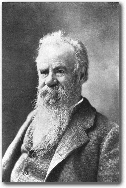
Arlington National Cemetery Print Share
|
|
Nearly 4 million visitors pay their respects to over 250,000 fallen service men entombed at Arlington each year. Arlington National Cemetery is also an active military cemetery, averaging 20 funerals each day. Tour Information The Arlington National Cemetery visitor center and parking facility are open during normal cemetery hours, 8 a.m. to 5 p.m. October 1 through March 31, and 8 a.m. to 7 p.m. from April 1 through September 30. Tours are self-guided, and cemetery and gravesite information may be obtained at the Visitor's Center. Arlington National Cemetery is located on the Blue Line of the Washington Metro System, though paid parking is availble from Memorial Drive. New Mexicans might want to see: Graves of Lt. General Arthur MacArthur and General John "Black Jack" Pershing
General John "Black Jack" Pershing (pictured at left) was stationed at Ft. Stanton, New Mexico, and later served in the Spanish-American War. Pershing led troops in pursuit of Pancho Villa, who raided Columbus, NM in 1916. Gen. Pershing would go on to command in WW I. He died in 1948, and is buried in Section 34, grave number 1.
Under the auspices of the United States Geological Survey, John Wesley Powell established the first official stream gaging station at Embudo, New Mexico, in December of 1888. Part of his Irrigation Survey, a large scale attempt to bring a systematic plan to irrigate the West, the Embudo Stream Gaging Station served as the nation's first field training center for hydrologists. Though the plan was never fully realized, the Embudo Stream Gaging Station is still in operation. View the current stream flow conditions of Rio Grande at the Embudo Stream Gaging Station. |
 Grave of John Wesley Powell
Grave of John Wesley Powell